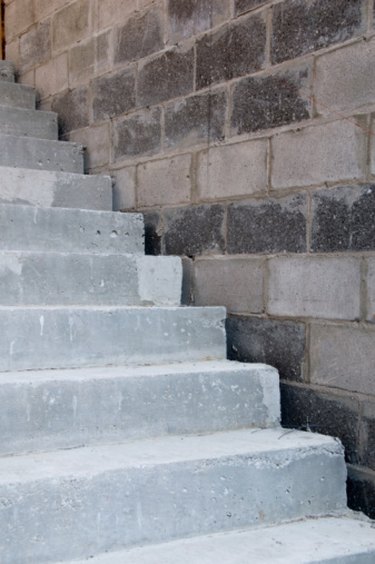Things You'll Need
Redgard
V-shaped trowel
Paint roller
Airless paint sprayer (optional)
Silicon sealant

Redgard is a liquid waterproofing and crack-prevention material that dries to a flexible membrane. For interior and exterior use, Redgard may be applied to surfaces such as concrete, exterior-grade plywood, decks and gypsum-based materials. It also functions as a moisture barrier beneath all kinds of floor coverings. Redgard comes in 1- and 3.5-gallon sizes and may be applied with a roller, trowel or airless sprayer.
Preparation
Step 1
Make sure all concrete surfaces are structurally intact, clean, dry and free of contaminants.
Video of the Day
Step 2
If you are planning to apply Redgard to new concrete, trowel the wet concrete smooth, then texture to a broom finish by passing a stiff-bristled broom over the wet concrete. Cure the concrete for at least four weeks prior to Redgard application.
Step 3
Treat cracks larger than 1/8 inch with methods that comply with the Tile Council of North America standard F125.
Application for Crack Prevention
Step 1
Pre-fill any gaps between plywood sheets in the subfloor and in the floor-to-wall joints with Redgard.
Step 2
Force Redgard into any existing cracks with a flat trowel, roller or brush. Smooth out the ridges of Redgard with a flat trowel to form a smooth, even coat over the cracks.
Step 3
Spread the Redgard membrane well beyond both sides of each crack with the trowel.
Step 4
Protect an entire substrate by covering it with a continuous coat of Redgard at a minimum wet thickness of 30 mils.
Application for Waterproofing
Video of the Day
Step 1
Pre-fill cracks up to 1/8 inch with Redgard before the waterproofing application.
Step 2
Dampen porous surfaces such as concrete, block or brick lightly with a water spray bottle.
Step 3
Pre-coat the corners and joints where floor and wall meet with Regard using a rough-textured roller or a V-notch trowel. Extend the application 6 inches on both sides of the joint.
Step 4
Spread the Redgard evenly over the entire surface using a flat trowel. Smooth out any ridges. For roller application, apply an even film with overlapping strokes.
Step 5
Apply Redgard with an airless sprayer at 1,900 to 2,300 pounds per square inch and with a flow rate of 1.0 to 1.5 gallons per minute for coverage of larger areas. Use a tip orifice size of 0.025 to 0.029 and apply in even, overlapping lines. After the first coat dries, apply a second coat. The total depth of dried coatings should be at least 30 to 35 mils.
Application at Drains
Step 1
Apply Redgard to the drain flange, the metallic collar that surrounds the drain tube and seals against the surface of the floor.
Step 2
Embed a 12-inch by 12-inch fiberglass mesh into the wet membrane coat of Redgard. After Redgard cures for one to one and a half hours, clamp the drain flange to the membrane and tighten.
Step 3
Apply silicon caulk around the flange where it contacts the membrane.
Application Over Concrete
Step 1
Clean and degrease the concrete surface.
Step 2
Prime the concrete with a concrete sealer or with Redgard diluted at one part Redgard to four parts clean water. Allow the primer to dry.
Step 3
Apply one coat of full-strength Redgard over the primer at 20 to 25 mils thickness. If water vapor transmission from the concrete exceeds ASTM F1869 single-coat standards, apply a second 20- to 25-mil coat.
Application at Expansion Joints
Step 1
Clean the joint and lay an open- or closed-cell backer rod into the joint to fill some of the gap. A backer rod is a flexible, rubber-like material that is laid in wide joints between building materials.
Step 2
Force sealant into the joint, coating the sides and making the sealant flush with the surface.
Step 3
Apply a coat of Redgard to a minimum of 1.2 mm thick over the joint. Once it's dry, install tile work or floor covering in the joint. To allow movement of the expansion joint, do not bridge the joint with the tile or floor covering.
Tip
Allow Redgard to dry until it is dark red in color, usually one to one and a half hours. Apply a second coat only after the first coat is dry.
Clean spray equipment immediately after use. Clean tools and hands with water while Redgard is still wet.